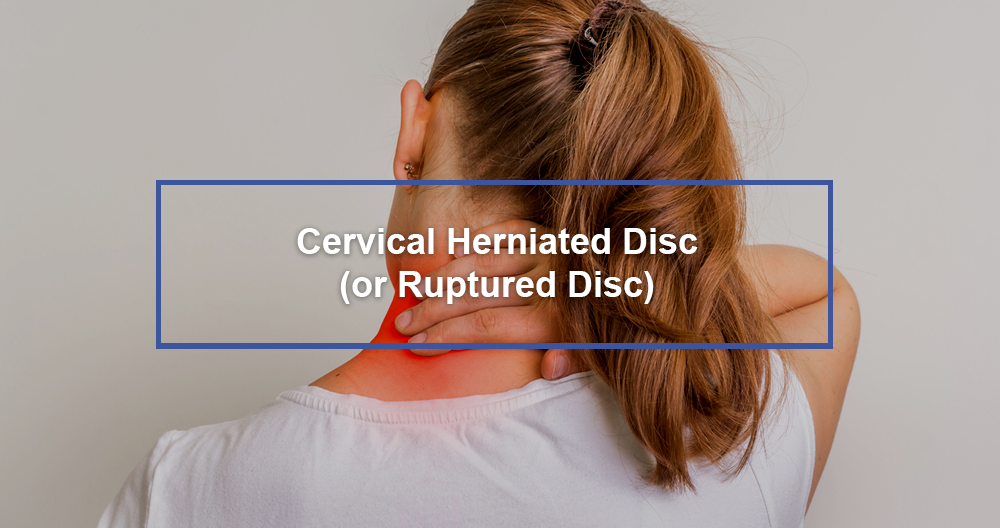
Sometimes, cervical disc herniation compresses the nerves of your neck, causing pain.
A common cause of upper and neck pain is cervical disc herniation. It can feel dull and sharp in the neck and between the shoulder blades. The pain may radiate down into the arms, hands, fingers, or legs. Some patients also report feeling tingling and numbness. Some movements and positions can increase or worsen pain.
Some patients may experience spinal cord compression due to a cervical herniated disc. The disc material presses on the spinal cord. This is a serious condition that may require more aggressive treatment. Signs of spinal cord compression include an awkward or stumbling gait as well difficulty with fine motor skills in your hands and arms. There may also be tingling sensations or “shock” feeling down the torso or into your legs.
A number of factors increase the chance of disc herniation
- Poor disc health can be caused by lifestyle choices, such as smoking and insufficient exercise.
- As our bodies age, natural biochemical modifications cause intervertebral discs to slowly dry out. This can affect disc strength as well as resilience.
- Poor posture, combined with poor body mechanics, can cause additional strain to the cervical spine.
Combining these factors with injury, daily wear and tear, incorrect lifting and twisting can make it easy to see why a disc might herniate. A disc herniation could occur suddenly or over several weeks or even months.
Stages of a Cervical Herniated Disc
There are 4 stages to a cervical herniated disc:
- Disc degeneration: Intervertebral discs weaken due to chemical changes. However, there is no herniation. This is part and parcel of aging discussed above. The disc can dry out, which makes it less able to absorb shocks from your movements. In this stage, the disc can become thinner.
- Prolapse is when the disc becomes displaced from the spine or the nerves. This stage can also be called a bulging disc, protruding disc.
- Extrusion: This is the gel-like nucleus of the intervertebral Disc that breaks through the tire-like wall (annulus fibrosus), but stays inside the disc.
- Sequestration, or Sequestered disc: The nucleus of the nucleus can break through the annulus Fibrosus and move into the spinal canal.
Accurate Diagnosis
A herniated disc may not cause symptoms in all cases. Unrelated reasons may cause a bulging disc or herniated disc to be discovered. It is often the symptoms that lead patients to seek medical advice. To diagnose accurately, the doctor will need to review the patient’s medical history and examine their neurological and imaging records (eg, CT scan, xray).
Non-surgical Treatment Options
Not everyone needs neck surgery. Patients often find nonsurgical treatment options that relieve their pain and symptoms in as little as 4 to 6 weeks. You can feel optimistic about your treatment and keep in mind that less than 5% of back problems need surgery.
- A non-steroidal anti inflammatory drug that reduces swelling, a muscle relaxant to relieve spasms and/or pain relief may be part of your medication.
- Physical therapy could include heat and cold treatment, gentle massage and stretching.
Optional Surgical Treatments
If pain and symptoms persist after nonoperative treatments have failed, cervical spine spine surgery may become necessary. Surgery may be necessary if the herniated disc compresses the spinal cord (i.e., myelopathy).
The purpose of spine surgery is to relieve the compression nerves caused by herniated discs. The most common procedure for discectomy involves either partial or complete removal of the damaged disc. An anterior discectomy (or anterior discectomy) is performed in this area. Sometimes, access to the herniated disc must be made from behind. To do this, a small amount of the lamina (a bony layer covering the spinal canal) can be removed. The procedure is called laminotomy or posterior laminotomy. Either procedure can often be performed minimally invasively or in an outpatient center for spine surgery. Cervical artificial disc replacement may be an option for some patients.
Can a cervical herniated or bulging disc be prevented
Although aging is inevitable and can be prevented by lifestyle changes, cervical disc disease can be prevented. Maintain good posture, body mechanics, regular exercise, and stop smoking.
How a Cervical Disc Herniates
In the cervical spine, there are six intervertebral discs. Each cervical disc is placed between adjacent vertebrae (one higher than the other) to cushion vertebral bodies and distribute load from the neck. Two components make up a disc.
- Annulus fibrosus. Concentric collagen fibers make this outer layer strong enough to protect the soft inner layer. The annulus Fibrosus is responsible for absorbing shocks and distributing heavy loads to the spine.
- Nucleus pulposus. This gel-like interior consists of loose network fibrils suspended in mucoprotein jelly and protected within the annulus Fibrosus. The nucleus fibrosus offers additional flexibility and cushioning for movement.
A herniated disc is when the outer layer of the disc tears or some of the nucleus pissosus seeps into the tear. A herniated disc is most often accompanied by pain caused by the nucleus Pulsus, which contains inflammation proteins. Sometimes, the herniated disc can leak onto your spinal cord.
Risk Factors of a Cervical Herniated disc
Age is a factor in the likelihood of developing a herniated or bulging disc. A cervical herniated disc most often develops between the ages 30, 50, according to some estimates. Most studies found that men are at greater risk of developing a cervical herniated dissection. However, a recent study suggested that women may also be at increased risk.
In adults, cervical herniated discs occur at a rate between 0.5% to 2%. Many cervical herniated disc cases go undiagnosed, so estimates may vary depending on population.
The Seriousness of a Cervical Herniated disc
Rarely, signs and symptoms of a cervical herniated disc may become worse than they resolve on their own. Tinting, numbness, or weakness can occur in the arm if the cervical nerve root is not removed. Similar problems may occur if the cervical herniated disc compresses or inflames the spinal cord. These types of neurological impairments need immediate medical attention to stop them from getting worse or becoming permanent.

